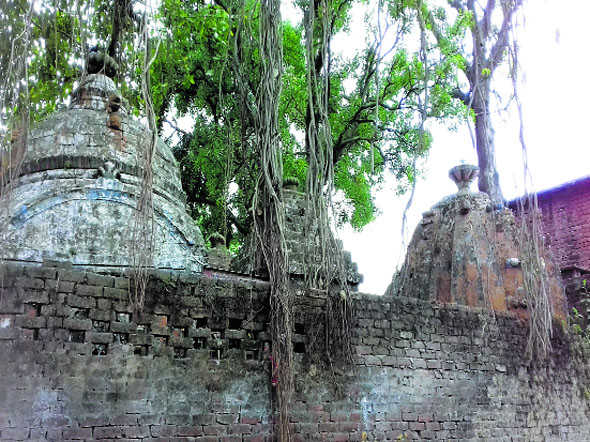Shriniwas Joshi
Mandi State Gazetteer of 1920 gives the list of the following places in Mandi state as the places of interest: Mandi town, Riwalsar, Kamlah fort, Nawahi, Parasar, Bairkot and Jhatingri. Of these seven places, two — Nawahi and Kamlah fort — fall in Sarkaghat subdivision. Nawahi is only 4 km short of Sarkaghat on the Mandi-Sarkaghat road. I saw it and was not pleased to see a modern structure where ‘aarti’ of the Devi was going on. I was told that the old temple had been renovated to the present façade in the year 1995. But on one side of the main temple, there were old structures of the temples, which define the age of the temples.
The name Nawahi is variously derived. Etymologist Vidya Chand Thakur in his book “Himachal Pradesh ke Sthaan Naam” writes that a bangle seller was passing through the temple one summer. He rested in the shadow of a broad-leaf tree. He was mesmerised to see a beautiful girl who came near him. She asked him to put bangles in her hand. He did so but after putting bangles in both the hands, he saw, with surprise, that she forwarded her third hand to be decorated. And then the fourth, fifth and so on till all her nine hands were adorned with bangles. She then eloped. The bangle seller then visited the neighbouring villages and told the people the story of his meeting with a girl with nine arms. The elders of the villages said they also had witnessed the presence of this girl at the same place but it was in dreams. After consulting the books concerned, the spot of the girl’s visits was dug where the people found a pindi (a raw and rough idol) which was installed there for worshipping. Gradually this spot was developed into a temple where thousands come to propitiate the Devi. The Devi was given the name of Naubahi because of her being nine armed; ‘bahi’ is arm. In the times to come, the name was corrupted to Nawahi.
SR Harnot in his book, “Himachal ke Mandir aur unse judi lok-kathayen,” repeats the same story but adds that Nawahi village was earlier called Sangroh. It was changed to Nawahi after the ‘pindi’ was found there. There is an idol of Sheetla Mata at the entrance which is worshipped before entering the temple. Sheetla is a folk deity and is an incarnation of Katyayini form of Durga. Sheetla means ‘one that cools’ and, therefore, cures poxes, sores, ghouls, pustules and diseases. When Katyayini assumed the form of Sheetla Devi, she carried a short broom in her hand to swipe the diseases, in her second had was a winnowing fan to give cool air to the diseased, jar of cold water in her third hand and a drinking cup in the fourth to take the thirst away from the ill.
Nawahi Devi temple stands amidst tall trees and the pond, said to be full with water, which was dry on the day of my visit. Immediately behind Nawahi Devi temple is a garish yellow-coloured temple of Lord Shiva and on one side of the main temple are the Shivalas. Nawahi Devi is ‘kulja’ (family goddess) of many villagers living nearby.
I tried to find a picture or painting of a Devi with nine arms but I could not. Goddess Durga has been shown having eight to 18 arms, but each figure had an even number of arms and none was with nine arms. Durga iconography has been flexible in the Hindu traditions. During Kushan Period (1st to mid-3rd centuries), Durga did not have the same figure as she has today. Her ride, at that time, was not the lion and she had only two hands. It was in the 5th century that Durga was shown with four hands. She had sword, spear and shield in her hands. It was between the 6th and the 12th century that the lion appeared as Durga’s vehicle. The spear was replaced by a trident and the number of arms touched from eight to 18. Durga appears in Hindu mythology in numerous forms and names, but ultimately all these are different aspects and manifestations of one goddess. But David Kinsley, a professor of religious studies specialising on Hindu goddesses, believes that iconographic features of Durga became common throughout India by about AD 4th century.
Anyhow, I agree with the Mandi District Gazetteer that reads that the most probable derivation of word Nawahi relates to the fact that there were situated nine temples formerly. The temples are said to have been despoiled by a Muhammadan attack and this attack could be from Sikandar Lodi in the 16th century, and ‘wahi’ in Hindi means something dilapidated, so ‘Nawahi’ means nine dilapidated structures.
Tailpiece
“The world which worships Mother Mary and Goddess Durga also has experienced such heinous crimes against her daughters.” - Debajani Mohanty
Unlock Exclusive Insights with The Tribune Premium
Take your experience further with Premium access.
Thought-provoking Opinions, Expert Analysis, In-depth Insights and other Member Only Benefits
Already a Member? Sign In Now










